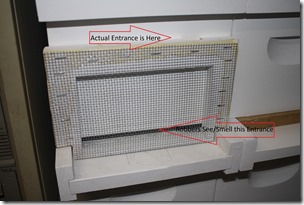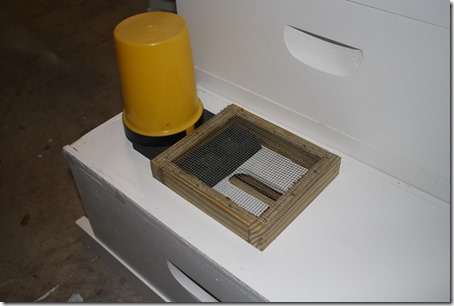Nucs Are Weak and Need Extra Defense
In most of the manipulations that involve using a nuc, the immediate result is a VERY weak mini colony. They tend to just have enough nurse bees to support a small cluster or larvae and a queen. Unless the new nuc was moved to another out-yard over three miles away (not an option for most backyard beekeepers) the cluster will loose nearly all of its foragers back to the originating hive. Even worse, there tend to not be enough extra bees to defend the hive from robbers and interlopers (SHB, Wax moths). Even it there is a heavy nectar flow, this little cluster of bees is missing the critical resources that it needs to thrive.
Reduce the Entrance!
I keep the entrance on nucs restricted to two bees wide and one bee high. In most cases I use a normal U.S. type bottom board. I cut entrance reducers for these bottom boards to block the bottom entrance except for a 3/8 X 3/16 slot on the bottom of the reduces. If I have a slotted inner cover on the nuc, I set the outer cover to block bees from using the inner cover slot as another entrance. I won’t open these up until the nuc has built up to at least four really full frames of bees and lots of foragers.
Use Robbing Screens
 Robbing screens are controlled gateways that restrict entrance to the hive to a non-obvious route. In the best case, they clearly provide a view of the main entrance and allow the scents of the hive out for robbers to see as an easy route into the hive. However, this clearly obvious path is blocked by a screen. Using robbing screens instead of entrance reducers allows the bees to use the front entrance for ventilation while giving them a defendable entrance.
Robbing screens are controlled gateways that restrict entrance to the hive to a non-obvious route. In the best case, they clearly provide a view of the main entrance and allow the scents of the hive out for robbers to see as an easy route into the hive. However, this clearly obvious path is blocked by a screen. Using robbing screens instead of entrance reducers allows the bees to use the front entrance for ventilation while giving them a defendable entrance.
Nucs Need to be Fed
For at least the first month (and possibly longer) a new nuc does not have the resources to raise new bees and forage. Small pollen patties (no more than the bees can consume in four days) and a good supply of sugar syrup can be critical to their survival. Ideally, the nuc would have been given a good resource frame with lots of honey and pollen, but many times that isn’t too easily done. It is best to feed just to be sure.
A real bad mistake that can be made when setting up feeder for a nuc is to use Boardman type entrance feeders. Even during a strong nectar flow, entrance feeders will encourage bees from any nearby hive (and yellow jackets and other opportunists). A small nuc can be completely robbed out in less than an hour if it becomes an obvious robbing target.
 If you have an extra nuc body or two, entrance feeders actually work pretty well on top of an inner cover (and protected by the extra nuc body). One thing that I have found helpful when doing this is building a small screened box to contain the bees to the open portion of the feeder. This makes it possible to change the feeder without having to dress up with a veil and smoke the nuc.
If you have an extra nuc body or two, entrance feeders actually work pretty well on top of an inner cover (and protected by the extra nuc body). One thing that I have found helpful when doing this is building a small screened box to contain the bees to the open portion of the feeder. This makes it possible to change the feeder without having to dress up with a veil and smoke the nuc.
View without nuc body to show feeder box.
Hive top feeders tend to not work very well if the night time temperatures fall much below 50 F. These enclosed feeders tend to work a little bit better as they moderate the temperature better than an exposed jar (see below). Additionally, the proximity of the place where the bees get their syrup is much closer to the cluster than is the case with full hive top feeders (which I do use in September when building up for Winter).
Jar Feeder Options
What might be considered the ‘classic’ way of feeding nucs is by using a migratory top with a hole cut in it for a 1 quart mason jar. These are rather simply made and are great expedient covers. Possibly the biggest problem making them is figuring out how to cut the 2 7/8 inch hole in the top, and once there is a hole, how to cover it when you get past the need to feed the nuc.
I bought an arbor style hole cutter from Harbor Freight for about $15.00 and cut the holes on my drill press while assembling these migratory covers.
I did discuss feeding pollen patties a bit earlier on this page. Typically, feeding patties involves either adding a shim or flipping the inner cover over to provide space between the top bars of the frames and the cover. Something that I have found helpful to facilitate feeding nucs is to build in a 3/8 inch spacer to the migratory cover. this only required a couple of thin strips glued and stapled to the bottom sides of the cover.

